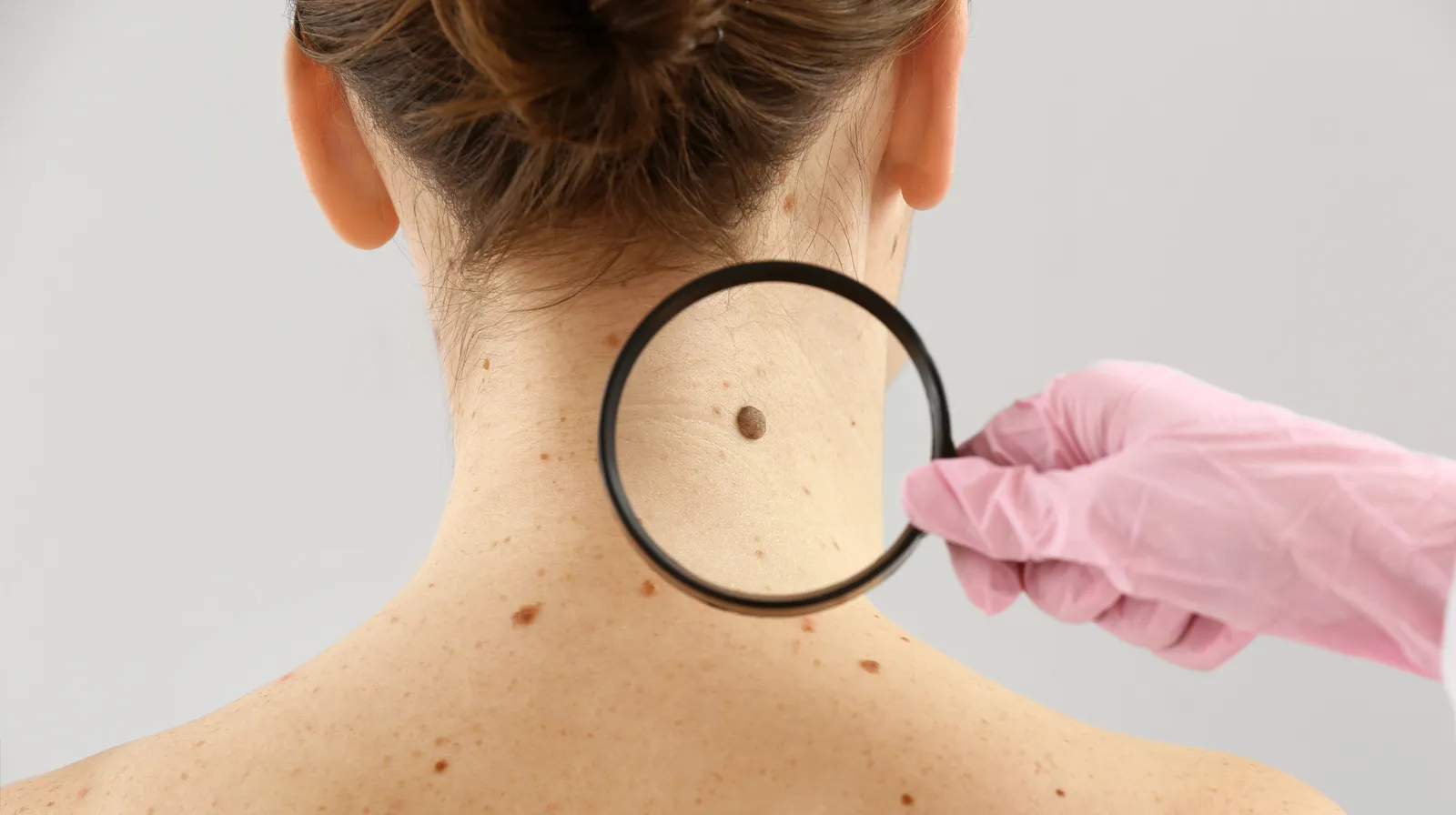
Birthmark: any mark, spot, or bump on the skin which is present at birth or appears shortly after birth in the infancy period is called birthmark.
Birthmarks are caused by the overgrowth of blood vessels, melanocytes, smooth muscle, fat, fibroblasts, or keratinocytes. Most birthmarks are harmless and do not cause medical problems.They are broadly classified as two types of birthmarks: Pigmented birthmarks & vascular birthmarks.
Pigmented birthmarks are formed by the accumulation of pigmented cells under the skin or abnormalities in skin color. Pigmented birthmarks can be flat or elevated. They may simply be due to excessive deposition of melanin pigment in the deeper layers of the skin called dermal melanosis. This is particularly common in more heavily pigmented infants.
Nevus of Ota: green colored mole generally on one side of the face, may be associated with dark patches in the eye.
Cafe au lait macules: coffee-colored flat patches.
Congenital Melanocytic Nevus: Nevus is due to the concentration of melanin-producing cells. These nevi are generally, small black thick mole with or without hair, no larger than the quarter-inch diameter. However, they can be quite large, covering a significant portion of the infant’s skin there is a small risk of skin cancer in larger moles.
Mongolian spots: green color patches on the body, generally clear spontaneously within one year of life.
Becker’s nevus: Dark brown colored patch with excess hair growth, appears during puberty.
Nevus Spills: a skin lesion that presents as a light brown or tan macule, speckled with smaller, darker macules or papules and also known as speckled lentiginous nevus and zosteriform lentiginous nevus
Vascular birthmarks are formed due to abnormalities of blood vessels under the skin. These birthmarks are red or purple in color.
Port-wine stain: The most common type of birthmark, appears commonly on the face as pink-red flat patches which turn purple-red; varies in size; can grow in size or look more prominent or raised from the skin as you grow older. Port-wine stains usually do not fade or disappear. These birthmarks may be a cosmetic concern if located on the face and some around the eye may be associated with eye and or brain problems. It affects at least 3 out of every 1000 babies.
Salmon patch: This is pale pink in color and often seen on the face or the neck after birth, and generally vanishes with time.
Hemangiomas: Red thick skin growths. Generally, most of them require treatment, and some of them clear with time. Among all the hemangiomas they aren’t really birthmarks, as they are often not present at birth, but appear in infancy. These hemangiomas need special attention by a dermatologist if they happen to occur near the eye, mouth, neck, and chin, and as they can obstruct the child’s ability to see, hear, eat, or breathe.
The treatment depends on the nature of the tissue, type of tissue involved, and the risk versus the benefit of treatments. Most birthmarks that are small and visually unpleasant require treatment for cosmetic reasons or because of rapid growth. Among birthmarks; vascular origin hemangiomas deserve the most attention. Any birthmark that is likely to impair either the physical (or) mental health of the patient is much more likely to b treated.
Birthmarks may grow in-utero or start growing soon after birth. Some birthmarks may start growing at age of 10 years to 20 years. Many birthmarks have extensions of dormant cells in hair follicles and tend to recur after treatment.
There are different ways that a birthmark can be removed, depending upon its type, size, location, and other factors.
Laser Therapy: Lasers are used to treat birthmarks that are close to the surface of the skin. This treatment can be performed at any age. During treatment, short bursts of laser light are aimed at the birthmark in order to shrink it or cause it to stop growing. Multiple visits may be necessary to achieve optimal results.
There are many lasers used to treat birthmarks. As pigmented birthmarks are effectively managed by Q-switch Nd: YAG laser, Co2, and Fractional lasers; and Vascular Birthmarks are best managed with Intense pulse light, long pulse Nd: YAG laser, and pulse dye laser.
Surgery: This method is used when other non-surgical treatments have not worked. A hemangioma that is large, or found on an internal organ also requires surgery. We at Clear Skin Laser Centre perform these below-mentioned treatments to effectively manage birthmarks.
Pigmented Birthmarks Laser Treatment: Those related to melanin (pigment) and melanin-producing cells such as nevus of Ota, naevus spilus, cafe-au-lait macules are treated with Q switched Nd Yag laser, Pico laser, and melanocytic nevus, Verrucous Epidermal Nevus are best treated with Carbon dioxide laser.
Q-Switched Nd: YAG laser & Pico laser: are gold standard lasers in removing pigmented lesions. These are q-switch nano and pico lasers with a high-powered technology to remove unwanted tattoos and pigmented lesions. It emits a highly focused beam of laser light, which passes harmlessly through the outer layer of the skin and is absorbed by the excess pigment within the lesion. As the light is absorbed, it is quickly converted to heat. The sudden rise in temperature target or fractures the ink or pigment into tiny particles and the pigmented lesions are naturally shed from the skin, one to two weeks after treatment.
Co2 laser: The carbon dioxide laser produces a specific wavelength of light in the mid-infrared spectrum (10600nm); this allows its laser energy to be well absorbed in water as a chromophore. In fact, co2 lasers are safe and precise ablation of melanocytic nevus, verrucous epidermal nevus, etc.
Vascular Birthmarks Laser Treatment: the combination of intralesional steroids and laser works better and prevent scarring in managing huge hemangiomas.
Pulse Dye Laser: considered as a gold standard, designed to rid patients of benign vascular lesions. The laser delivers an intense but gentle burst of yellow light to the skin. The light is specifically absorbed by the blood vessels in the dermis. These blood vessels are coagulated and then reabsorbed by the body during the natural healing process.
Long pulse Nd: Yag Laser: that produces laser emission at the wavelength of 1064nm., and it has the capacity to reach deeper layers of the skin and readily absorbed by hemoglobin to remove deep-seated benign vascular lesions such hemangiomas
Most of the birthmarks require multiple sessions and the treatment is done at monthly intervals. Most of the changes occurring following the treatment will settle within 5-7 days and won’t affect the daily activities. Laser treatment is safe, the out-patient procedure doesn’t involve surgery, blood loss, general anesthesia, hospital stay.
Surgery: This method is used when other non-surgical treatments have not worked. A hemangioma that is large, or found on an internal organ also requires surgery under general anesthesia. Excision or serial excision or dermabrasion may be required.
Radio-Surgery: This is a revolutionary technique to remove unwanted skin growths, an easy and faster method with ultra-high-frequency radio waves (3.8 MHz) to cut and coagulate tissues without much trauma, bleeding, or scarring. This treatment is done under local anesthesia and most of the time requires only a single session. We at Clear Skin perform radio-surgery excision of melanocytic nevus, nevus sebaceous of jadasohn by most advanced Ellmann Surgitron(USA) & Kentamed RC
Hemangioma which is rapidly growing, compressing vital structures, ulcerated & bleeding ones
Nevus sebaceous: long-standing which can transform into malignancy at age 40 and above.
Melanocytic nevus: larger than 2 cm.
We at Clear Skin Laser Centre is equipped with the most advance and time-tested world-class technology; Q-Switch nano & pico lasers, pulse dye laser and long-pulse Nd: YAG lasers approved by USFDA to handle all these pigmented and vascular birthmarks effectively; under the eminent guidance of Dr.N.Kailash MD., Dermatology.
